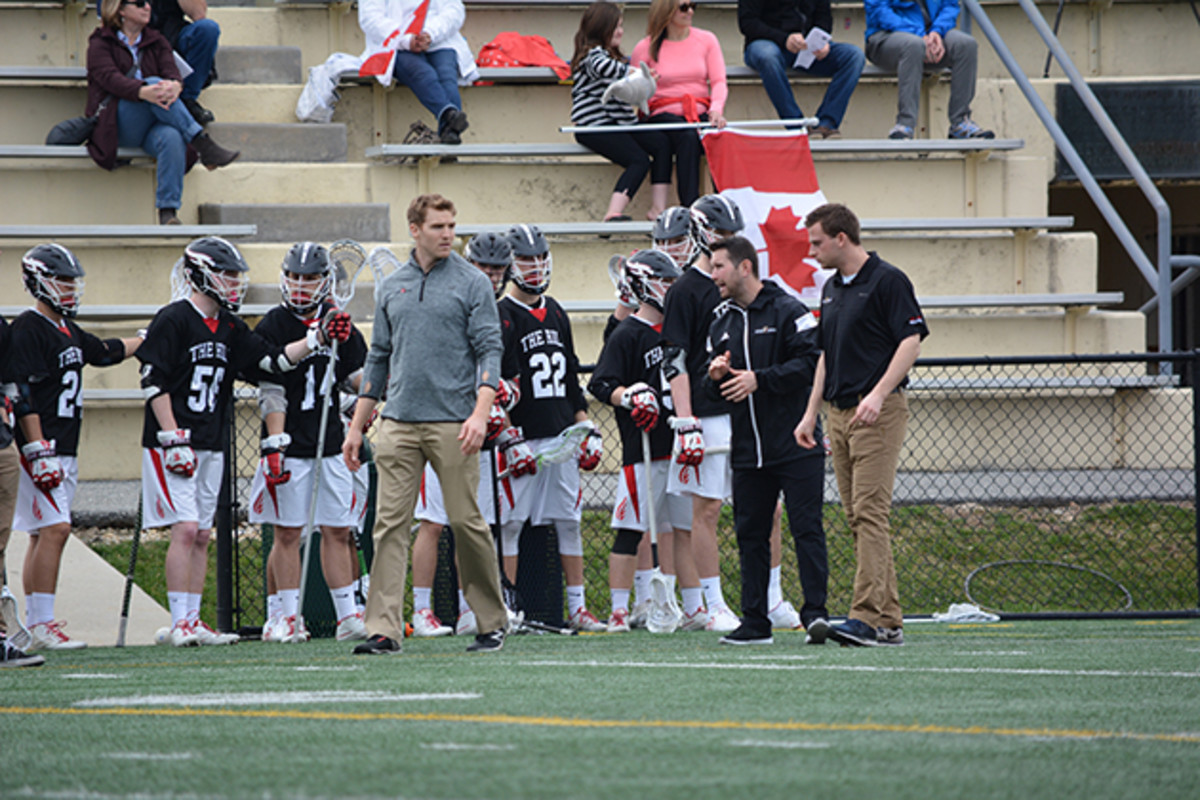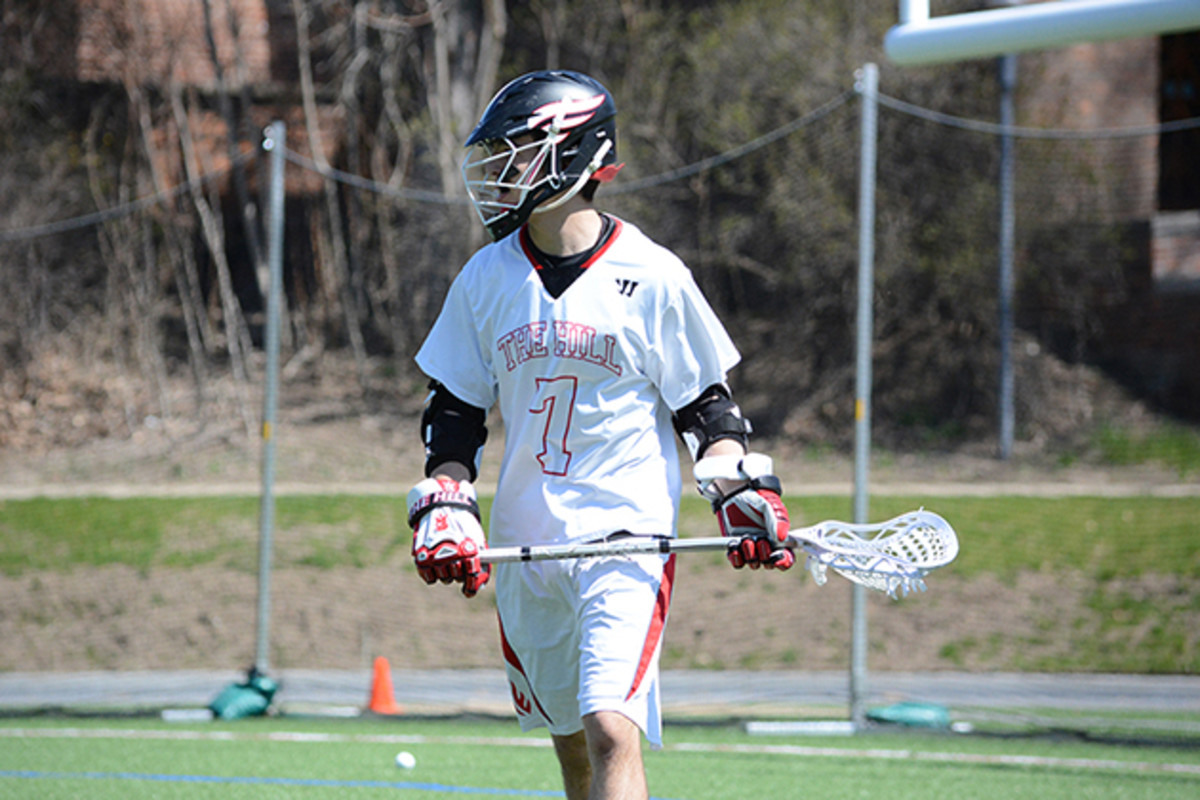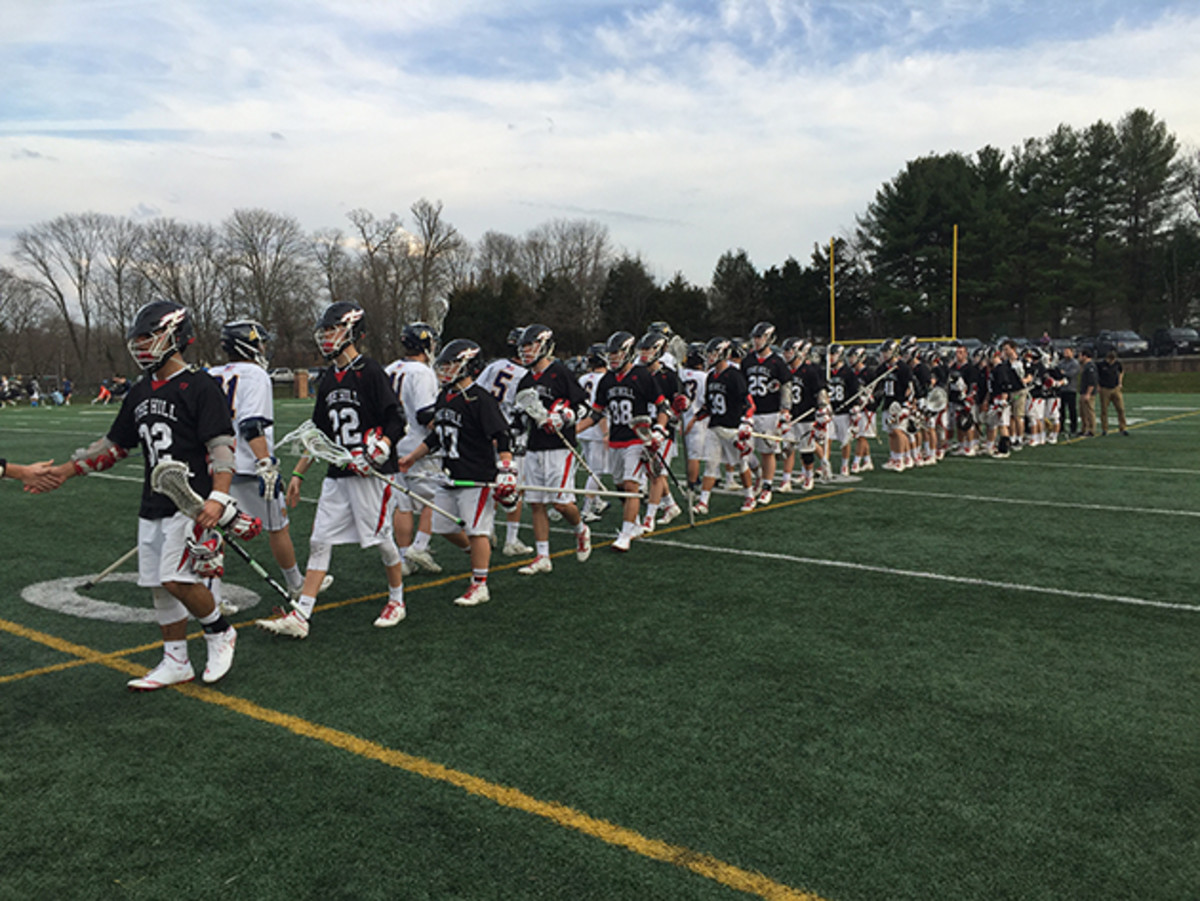The rise of high school lacrosse powerhouse The Hill Academy

Around 100 Explorers fans crowd a grassy slope above the La Salle College High School turf field. Some wear untucked Oxford shirts, khakis, and boat shoes. Others sport blue and gold gym clothes or baseball uniforms. A husky student has on American flag patterned boardshorts. That sartorial choice might be because it’s 78 degrees and humid this Friday afternoon in late April in eastern Pennsylvania. More likely, it’s because The Hill Academy from Ontario, Canada—the world’s No. 1-ranked high school lacrosse team—is already leading La Salle 4-0. There’s two minutes left in the first quarter.
Other statements of nationalism are less subtle. From Bruce Springsteen’s “Born in the USA,” blaring from the loudspeakers during warm-ups, to the student section’s full-throated rendition of “America the Beautiful” during the game, to jeers including “Canadian bacon sucks!” the atmosphere is suffocating.

. He paces the sideline with a measured gait. He doesn’t yell.
When La Salle cuts Hill’s lead to 6-2 with 4:34 remaining in the first half, cheers of “USA! USA! USA!” drown out the Fort Washington Expressway rush hour traffic. You would think it was Lake Placid in 1980 instead of Glenside, Pennsylvania.
One-legged high school mountain biker KC Fontes defies the odds
“That was a bit more than what we have seen,” Merrill will say later about the “peanut gallery” positioned behind Hill’s bench. “But we view it as exciting that all these teams are waiting for us. It makes it a fun environment and our players usually respond to it well.”
A decade ago Hill was little more than a concept. The independent school was founded in 2006 by the Merrill family and designed to fill a need for “dedicated student-athletes.”
“The thing that really struck us was it is so tough to achieve both academically and athletically,” Peter Merrill, Brodie’s father and the CEO and Founder of Hill, says. “Usually one suffers for the other.”

He had seen it first hand, no only several years teaching in the Ontario public school system, but also in their household. Peter remembers nights when Brodie would get home after junior hockey or lacrosse and try to finish his homework, only to fall asleep—exhausted. But after enrolling at Salisbury School in Connecticut, he earned a lacrosse scholarship to Georgetown and, according to his father, also won Salisbury’s math award. Patrick, Brodie’s older brother, experienced a similar trajectory at Mercyhurst College, where he played lacrosse and became a first-round draft pick for the NLL’s Toronto Rock in 2002. “We thrived in that situation,” Patrick Merrill says of the structured environment.
“Why don’t we have a variation on that theme up here in Canada specifically for athletes?” Patrick asked one night during a family dinner.
They went to work. They contacted the ministry of education and applied for accreditation. They spread the word in their hometown, the lacrosse hotbed of Orangeville, Ontario. Their first year, in 2006, they had 16 student-athletes and held classes at a conference center in Orangeville. By the second year they relocated to three houses in the village of Kleinberg. The 24 students practiced at a community park, trained at a local gym, and got their lunches from the Avenue Market Café.
Innovation in Hydration: Sweat testing is next level of sports hydration
“We made it work,” says Nils Thompson, who attended Hill from 2007 to 2009 and went on to captain the Bryant University lacrosse team.
Thompson’s first year at Hill was also the school’s inaugural trip to the Mid-Atlantic during spring break. Peter Merrill got his bus license so he could drive them. Their first opponent was not a tune-up game. The scrimmage was against Loyola Blakefield in Towson, Md., then ranked first in the in the US. Hill had 16 players. Loyola had closer to 50.
“Where’s the rest of your team?” a parent from Loyola asked Peter Merrill, after they arrived late.
“Well,” Merrill replied. “This is it.”
It was more than enough. Hill won 11-8.
“That game put us on the map,” Peter Merrill says.
****
Now, Hill Academy has 185 student-athletes divided amongst four lacrosse teams—three boys’ and one girls’ (coached by Tory Merrill)—and three hockey teams. Now, their classrooms are located next to the Sports Village in Vaughan, Ont. “We are not your traditional prep school in the mountains,” Peter Merrill says.
“We always look at ourselves as a lot of cake and less icing,” Brodie Merrill adds. “We just want to focus on the cake of our program.”
The core of the program is its unique schedule and year-round, sport-specific athletics. “Number one, we are not season oriented,” Peter Merrill says. Whether it’s hockey or lacrosse, “they have a stick in their hands all year.” A typical day starts at 8:30 a.m. with a 70-minute workout. That’s followed by practice for an hour to 90 minutes. Lunch, then a “mindfulness period.” Classes go from noon to 4 p.m.
The SI Extra Newsletter Get the best of Sports Illustrated delivered right to your inbox
Subscribe
“It’s not for everyone,” Patrick Merrill says of the school’s structure. “When we meet with families that are interested in the program, we are very up front. It is more like a college program than a high school program in terms of commitment.”
They’ve expanded every year. They have a sports scientist on staff. Members of the student body hail from as far away as Sweden, Australia, Israel, and Mexico, just to name a few. But 80% of the student athletes—and the majority of the lacrosse teams—are from Southern Ontario and commute 45 minutes to an hour each way. The composition of the varsity lacrosse team attracted even more attention when they toppled the United States U-19 national training team 16-11 at Ohio Stadium.
Perhaps it shouldn’t have been a surprise. Hill Academy’s roster comprises 10 of the 24 players on the Canadian U-19 team that will play at the World Championships in July.
But the success extends beyond high school. From Mike French, who propelled Cornell to an unbeaten record and NCAA Title in 1976, to Dave Huntley who won championships at Johns Hopkins in 1979 and 1980, to the Gait Brothers and their high-flying play at Syracuse in the late ’80s, over the past 40 years the Great White North has established itself as a prime source for college lacrosse talent.
While the influx of Canadians at the next level of the sport is not a new development, there has been a recent surge. According to Jason Donville, a former member of Team Canada’s board of directors who monitors the number of Canadians in college lacrosse, fewer than 40 Canadians in 2001 were on NCAA lacrosse rosters in Division I, II, and III combined.
Last year, there were 157 Canadians in Division I alone.

Vital to Hill’s dominance is their background in box lacrosse, which is played on converted hockey rinks with six players on a side. The repetition in tighter confines combined with smaller goals, faster pace, and a physicality that resembles hockey is evident every time Hill takes the field. They are relentless on ground balls. Their shots are pinpoint accurate. Their offense emphasizes motion, picks, screens, and quick passes instead of isolation dodges. “It’s totally different,” Cameron Close, a Hill post-graduate student from McKinney, Tex., says of their style of play. “One-hundred-and-eighty degrees from what I was used to.”
But while Canada has been heralded for its bevy of scorers, Hill has started to counter the assumption that its prowess is limited to the offensive end, as Brodie Merrill first demonstrated when he was a two-time Tewaarton trophy finalist at Georgetown. “When you used to think of Canadians you thought of just crease attackmen,” says Ty Xanders, founder of Recruiting Rundown. “But the Hill Academy has really nixed that stigma and proved they’re much more complete.”
Four of Hill’s U-19 team selections are defensemen.
Training with Jayron Kearse: Clemson safety takes workouts to the beach
With a little over a minute left in the first half, Jeff Henrick, Hill’s co-captain and a senior defensemen, executes a flawless takeaway check and races into the offensive end for a fast break. Three passes and a layup shot on the crease later, Hill extends the lead to 8-2. The play could be in an instructional video.
“They are like the Harlem Globetrotters,” a La Salle teacher says, shaking his head.
The remarks from the student section are less flattering.
“Hey seven, how old are you?”
“Hey seven, are your kids here?”
“Number seven, do you have a 401k?”
Everyone in the student section laughs.
****

Hill is used to the heckling. “We face the misconception that all our players are older and that is not the case,” Brodie Merrill says. “You are not allowed to repeat in the Ontario system and NCAA rules are strict when it comes to age. Some, not all, of our players choose to take an extra year of high school. You see repeating, or a PG year in the U.S. much more frequently I find.”
Jeff Teat is one of those post-graduates. His age is not the issue—he turned 19 this past weekend. It’s that no one can stop him. The Cornell-bound, left-handed attackman from Brampton, Ontario, is Hill’s quarterback. A co-captain, Teat is the only player on the team in the top 50 of Inside Lacrosse and Recruiting Rundown’s 2016 commit rankings (29th and 30th respectively). He has a cerebral approach and fluid grace on the field. Some of his passes seem telepathic. Two or three defenders are usually required to dislodge the ball from his crosse. Sometimes that isn’t enough. He scored eight goals against the USA U-19 team, that Lacrosse Magazine noted, “defy brief description.” He added three assists.
On his second goal this afternoon, he catches a pass on the crease, absorbs two checks, fakes out the goalie then buries the shot. He tallies a hat-trick in the first quarter.
“Some would say he is playing like the best [high school] player in North America right now,” Casey Vock, an editor at the recruiting website 3d Rising, says. “Everyone believes he can elevate Cornell to where they would be a championship contender today if they had him.”
Teams have tried to shut Teat off. IMG Academy did. So did Culver Academy. It didn’t work. Hill’s offense is the opposite of a one-man show. “When you try to lock off one player and remove that slide, it give so much more time to develop offense and room to shoot,” Dalton Follows, a post-grad midfielder at Hill and Harvard commit, says. “That is why we were able to put so many in on them so fast.”
Hill beat IMG 18-8 and Culver 12-4.
****
But in the second half against La Salle, Hill’s aura of invincibility seems to wear off. Passes are dropped. Shots are stuffed. They’re called for two penalties within one minute. La Salle capitalizes. They muster five goals in the third quarter and narrow the lead to 10-7.
“USA! USA! USA!” the Explorers chant.

Hill looks out of sync. They won’t tell you that they drove over eight hours to this game, that sometimes they’re not provided a locker room to change in, that they play no home games, and that they don’t want to jinx their undefeated season before their final two games this weekend. Instead, they’ll say their spring break trip, on which they play five games in six days, is a “great opportunity.” They’ll stress “the process,” or as Teat says “if we stick to the process the result will take care of itself.” It’s their policy: No Excuses, No Explanations. The motto is on the wall of their gym.
On another wall there are 15 wood planks, each with a saying like “Know thyself,” “Keep a Blue Head,” and “Pass the Ball,” the last of which has a lacrosse ball imbedded in it. They’re from the book Legacy by James Kerr about the leadership principles of the New Zealand national rugby team, known as the All Blacks. They’ve also been the catalyst for Dan Noble, Hill’s Director of Athlete Performance, to reconfigure the lacrosse team’s training methods and motivate the team. Hill has won 44 games in the past three seasons.
Last year they lost one game.
How to get your body used to working out in hot weather
Still, Noble wasn’t satisfied. “What is the definition of insanity?” he asks. “Doing the same thing and expecting different results.” He removed “pointless sprinting,” and re-emphasized running mechanics. He replaced the team’s traditional warm up with 20 minutes of “athletic development” that ranges from medicine ball throws, to squat jumps, to core work. He added one day of “chaos,” once every week that consists of a random workout and is designed to present an adverse situation. “I want to see how they respond,” Noble says.
With less than two minutes in the fourth quarter, Hill is hanging on, 11-10. It’s the most goals they’ve surrendered this season. But despite the pressure, they seem fresh, even loose.
Members of La Salle’s JV lacrosse team join the student section since their game finished. They unfurl an American flag and start waving it.
Teat has the ball. He jogs behind the goal then waits, surveying his options. He sprints to the right—five yards above the goal line. He turns around. He draws another defenseman. He’s a few feet from the goal but doesn’t shoot. He throws a no-look, behind-the-back pass to midfielder Damon Curry who scores before La Salle’s goalie can even react. 12-10. It is Teat’s fifth assist.
The Explorers are silent. The clock hits zero. A few students clap. They roll up the flag and hand it to their principal.
They walk back up the hill.
